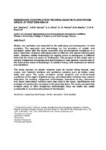Indigenous Construction Technologies in Flood-Prone Areas of Western Kenya

View/
Date
2007Author
China, S. S.
Waswa, George
Kundu, P.M.
Omuterema, S.O.
Metadata
Show full item recordAbstract
Shelter and sanitation are essential for the well-being and development of most
societies. The approach and technology for the provision of shelter and
sanitation varies with the social, economic and environmental conditions of a
place. Sanitation of places with piped water is different with places without piped
water. Likewise, shelter technology for regions prone to earthquake is different
from that for areas not prone to earthquake. The purpose of this study was to
identify indigenous knowledge and technologies in post-disaster construction in
the flood prone areas of Budalang’i, in western Kenya, with emphasis on shelter
and sanitation.
The study focuses on shelter systems such as; human living houses, food
stores, and livestock shelters; and sanitation systems such as toilets, water
wells and pans. The study considers social, physical and environmental
conditions of the region. Baseline survey, and observation methods were used to
determine the existing indigenous technologies. Interviews of key informants
and direct observation methods were also used in the study. Identification and
analysis of construction concepts in the area was done. The study recommends
in-depth study of other indigenous technologies since are useful and easily
sustainable in reconstruction phase of the disaster.
